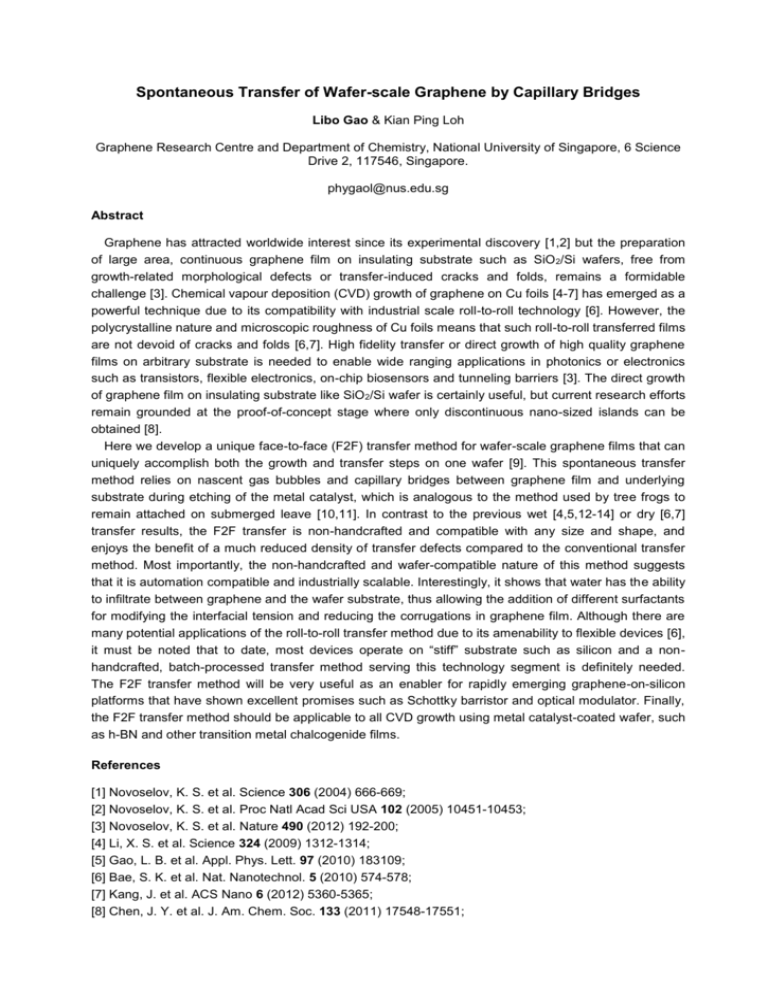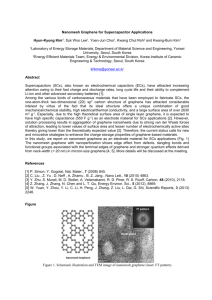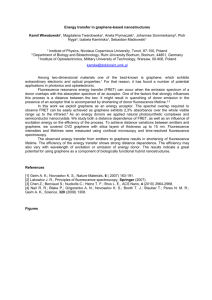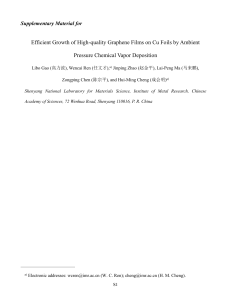Graphene Research Centre and Department of Chemistry, National
advertisement

Spontaneous Transfer of Wafer-scale Graphene by Capillary Bridges Libo Gao & Kian Ping Loh Graphene Research Centre and Department of Chemistry, National University of Singapore, 6 Science Drive 2, 117546, Singapore. phygaol@nus.edu.sg Abstract Graphene has attracted worldwide interest since its experimental discovery [1,2] but the preparation of large area, continuous graphene film on insulating substrate such as SiO 2/Si wafers, free from growth-related morphological defects or transfer-induced cracks and folds, remains a formidable challenge [3]. Chemical vapour deposition (CVD) growth of graphene on Cu foils [4-7] has emerged as a powerful technique due to its compatibility with industrial scale roll-to-roll technology [6]. However, the polycrystalline nature and microscopic roughness of Cu foils means that such roll-to-roll transferred films are not devoid of cracks and folds [6,7]. High fidelity transfer or direct growth of high quality graphene films on arbitrary substrate is needed to enable wide ranging applications in photonics or electronics such as transistors, flexible electronics, on-chip biosensors and tunneling barriers [3]. The direct growth of graphene film on insulating substrate like SiO2/Si wafer is certainly useful, but current research efforts remain grounded at the proof-of-concept stage where only discontinuous nano-sized islands can be obtained [8]. Here we develop a unique face-to-face (F2F) transfer method for wafer-scale graphene films that can uniquely accomplish both the growth and transfer steps on one wafer [9]. This spontaneous transfer method relies on nascent gas bubbles and capillary bridges between graphene film and underlying substrate during etching of the metal catalyst, which is analogous to the method used by tree frogs to remain attached on submerged leave [10,11]. In contrast to the previous wet [4,5,12-14] or dry [6,7] transfer results, the F2F transfer is non-handcrafted and compatible with any size and shape, and enjoys the benefit of a much reduced density of transfer defects compared to the conventional transfer method. Most importantly, the non-handcrafted and wafer-compatible nature of this method suggests that it is automation compatible and industrially scalable. Interestingly, it shows that water has the ability to infiltrate between graphene and the wafer substrate, thus allowing the addition of different surfactants for modifying the interfacial tension and reducing the corrugations in graphene film. Although there are many potential applications of the roll-to-roll transfer method due to its amenability to flexible devices [6], it must be noted that to date, most devices operate on “stiff” substrate such as silicon and a nonhandcrafted, batch-processed transfer method serving this technology segment is definitely needed. The F2F transfer method will be very useful as an enabler for rapidly emerging graphene-on-silicon platforms that have shown excellent promises such as Schottky barristor and optical modulator. Finally, the F2F transfer method should be applicable to all CVD growth using metal catalyst-coated wafer, such as h-BN and other transition metal chalcogenide films. References [1] Novoselov, K. S. et al. Science 306 (2004) 666-669; [2] Novoselov, K. S. et al. Proc Natl Acad Sci USA 102 (2005) 10451-10453; [3] Novoselov, K. S. et al. Nature 490 (2012) 192-200; [4] Li, X. S. et al. Science 324 (2009) 1312-1314; [5] Gao, L. B. et al. Appl. Phys. Lett. 97 (2010) 183109; [6] Bae, S. K. et al. Nat. Nanotechnol. 5 (2010) 574-578; [7] Kang, J. et al. ACS Nano 6 (2012) 5360-5365; [8] Chen, J. Y. et al. J. Am. Chem. Soc. 133 (2011) 17548-17551; [9] Gao, L. B. et al. Nature 505, (2014) 190-194; [10] Federle, W., Barnes, W. J. P., Baumgartner, W., Drechsler, P. & Smith, J. M. J R Soc Interface 3 (2006) 689-697; [11] Persson, B. N. J. J. Phys.: Condens. Matter. 19 (2007) 376110; [12] Reina, A. et al. Nano Lett. 9 (2009) 30-35; [13] Kim, K. S. et al. Nature 457 (2009) 06-710; [14] Gao, L. B. et al. Nat. Commun. 3 (2012) 699. Figure 1 Illustration of F2F transferring graphene mediated by capillary bridges.







